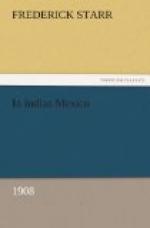Twenty-five or thirty of the more important men of the village were now taken to the schoolhouse, where the presidente inquired, for me, in regard to the costumbre. At first a little hesitancy was shown, but soon all were interested and talked freely. The costumbre comes at about the same time each year, though not upon a fixed date. Its purpose is to secure health, good weather and crops for the coming year, though it may be held on the occasion of pestilence. Everyone, even widows and old maids, brings something for the feast. The celebration is held in some large house, and lasts through two days; floral decorations are arranged in the four corners of the room, candles are lighted, and copal is burned. The first day, each person brings a handful of earth from his field, which is placed in a heap upon the floor. Fowls and animals are slaughtered for the occasion; their heads are cut off and their blood is sprinkled upon the earth. After feasting and drinking, a dance follows, the dancers wearing crowns and necklaces of yellow arnica flowers, and carry in their hands wands made of pine-splints wrapped with corn-husks, and with a flower of arnica tied to each end. The second day, corn on the ear and beans are brought instead of earth, and these are sprinkled with blood. On both days, blood-sprinkled material is carried home, and the seed and earth are later put into the field. In the feasting-room, two paper lanterns are hung from the ceiling; these are stuck over with gilt and colored paper disks and stars. They represent the sun and stars. Upon these lanterns a cross of blood is made, at the time when the earth and seed are sprinkled. After the dance ends on the second day, children shoot at the lanterns with small arrows and try to break them. Disappointed that no mention had been made of bark paper in connection with this ceremonial, we asked whether they ever used it. They answered promptly in the affirmative. For what? To wrap ocotes. With this, the man who told me hastened out and came back with a little parcel in his hand. This consisted of twelve little sticks of pine about three inches long; they were tied together with a band of thread or bark fibre, and were stained with blood; these were wrapped in a piece of green banana leaf, the upper face of the leaf being placed inside and the base of the leaf kept downward. When it had been thus carefully folded, it was carried to the field and buried in a hole, carefully dug, so that the top of the package was close to the surface of the ground, and the face of the leaf wrapping was directed toward the rising sun. To anyone who has studied American indian religions, these two costumbres suggest much of interest.




